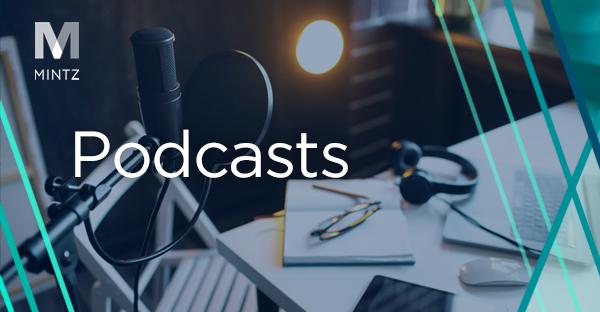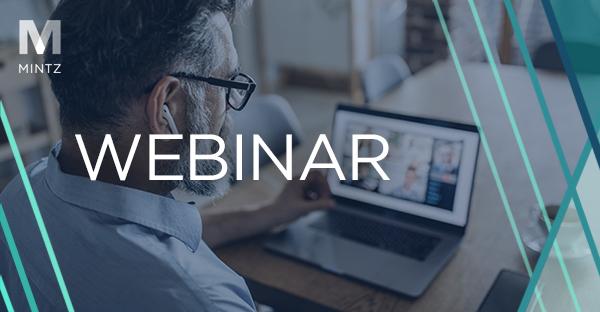
Employment
Viewpoints
Filter by:
Retirement Committee Field Guide: The Basics of Retirement Committee Organization and Operation – Part 1
March 11, 2021 | Podcast
In this inaugural episode in our series, Mintz’s Alden Bianchi interviews Marsh & McLennan Agency’s Bob Clark to explore the basics of retirement plan governance, with a particular focus on the following topics:
Read more
Agencies Issue Needed Guidance on COBRA Elections During the COVID-19 “Outbreak Period”
March 3, 2021 | Blog
On February 26, 2021, the Department of Labor’s Employee Benefits Security Administration (EBSA) issued Notice 2021-01 (the “Notice”). The Notice was issued jointly with the Department of the Treasury, the Internal Revenue Service and the Department of Health and Human Services (the “Departments”). Entitled “Guidance on Continuation of Relief for Employee Benefit Plans and Plan Participants and Beneficiaries Due to the COVID-19 (Novel Coronavirus) Outbreak,” the Notice provides much needed guidance to group health plan sponsors on (among other things) when COBRA notice and election periods, which had been previously extended [in May 2020], will come to an end. This guidance was necessary because earlier regulatory relief extending COBRA notice and election periods was about to expire as a result of a statutory deadline. This post explains the impact of the Notice on sponsors of group health plans.
Read more
Navigating Voluntary COVID-19 Vaccination Programs & Incentives
February 19, 2021 | Blog | By Corbin Carter
As COVID-19 vaccines become more available, employment-based programs requiring or incentivizing employee vaccination will become more commonplace. In a previous post, we covered recent employer guidance from the CDC, with a particular focus on mandatory workplace testing programs. This post examines how an employer might design a voluntary workplace vaccination program using incentives to encourage participation, and how to avoid potential pitfalls in doing so.
Read more
Getting Back to Basics: Intermittent FMLA Leave
February 17, 2021 | Blog | By Delaney Busch
In concept, the FMLA is simple. In practice, however, administering FMLA leave, particularly on an intermittent basis can quickly become complicated, and many employers struggle trying to track and manage intermittent leaves. This post addresses some of the intermittent leave-related issues employers may face and offers best practices for ensuring compliance with the law.
Read more
New York State Department of Labor Updates Guidance on COVID-19 Leave Law
February 10, 2021 | Blog | By Corbin Carter, Michael Arnold
The New York State’s Department of Labor recently issued new Quarantine Leave guidance for 2021 – guidance that is certainly controversial in that it seemingly goes beyond the statutory text of the NY COVID-19 Quarantine Leave Law to create expansive new employer mandates. We previously wrote about New York’s COVID-19 leave requirements here and here. While the new guidance seems ripe for legal challenge, it nonetheless reflects the new position of the NYSDOL. Employers should review this new guidance – keeping in mind its informal, non-binding nature – as the pandemic continues to affect leave decision-making.
Read more
CDC Issues Expanded Guidance for Workplace COVID-19 Testing Programs
February 5, 2021 | Blog | By Danielle Bereznay, Michael Arnold
The CDC has issued new guidance focused on ensuring employees’ informed consent for COVID-19 testing in the workplace. This builds on earlier guidance the CDC issued regarding workplace testing programs last fall. Because the CDC notes that employers should not conduct testing without an employee’s informed consent, employers should be prepared to answer employee questions and concerns by utilizing the recommend framework discussed below.
Read more
The Impact of the Consolidated Appropriations Act on Flexible Spending Arrangements
January 25, 2021 | Blog
In this post we begin an in-depth examination of these provisions starting with the Consolidated Appropriations Act’s effect on flexible spending arrangements, which provides employers with an expanded set of options to allow mid-year election changes.
Read more
Webinar Recording: Mandatory or Voluntary Workplace Vaccination – Guidance for Employers
January 15, 2021 | Webinar | By Geri Haight, Joanne Hawana, Jennifer Rubin
Watch this webinar in which Mintz’s Employment, Labor & Benefits and Health Law attorneys and noted immunologist Dr. Darryl Carter discussed key takeaways from the EEOC’s recently updated vaccination guidance and other COVID-19–related workplace questions.
Read more
Overview of the Impact of the Consolidated Appropriations Act on Employee Benefit Plans, Programs and Arrangements
January 13, 2021 |
Recently enacted H.R. 133, the Consolidated Appropriations Act, 2021 (“the Act”), is a massive, 5,593-page piece of legislation that includes appropriations for the U.S. government for the upcoming fiscal year and funding for coronavirus emergency response and relief, among many other things.
Read more
WEBINAR REMINDER: Mandatory or Voluntary Workplace Vaccination — Guidance for Employers
January 13, 2021 | Blog | By Geri Haight, Jennifer Rubin, Joanne Hawana
Please join Mintz’s Employment, Labor & Benefits and Health Law attorneys and noted immunologist Dr. Darryl Carter for a webinar to discuss key takeaways from the EEOC’s recently updated vaccination guidance and other COVID-19–related workplace question.
Read more
Transcript: “Pay Equity – What Compensation Committees Need to Know”
January 13, 2021 | Blog | By Anne Bruno
Read the transcript of CompensationStandard.com’s November 2020 webcast titled, “Pay Equity: What Compensation Committees Need to Know” in which Anne L. Bruno was among the experts to discuss pay equity, shareholder expectations, disclosure trends, board oversight, and more.
Read more
New York City Amends Fair Chance Act, Further Limits Employers’ Consideration of Criminal History
January 8, 2021 | Blog | By Corbin Carter, Michael Arnold
The New York City Council has expanded NYC’s Fair Chance Act to further restrict NYC employers from taking adverse actions against applicants or employees based on their criminal history. The law will go into effect on or about July 28, 2021. We highlight the changes in the law and action items below.
Read more
Massachusetts Paid Family and Medical Leave Law – January 2021 Update for Employers
January 8, 2021 | Blog | By Natalie C. Groot, Patricia Moran, Emma Follansbee
Happy New Year! While many of us are thrilled to see 2020 in the rear view, 2021 ushers in a huge challenge for Massachusetts employers – the beginning of benefits and Job protections under the Massachusetts Paid Family and Medical Leave law (MAPFML).
Read more
California East? D.C. Passes Comprehensive Ban of Non-Compete Agreements
January 8, 2021 | Blog | By David Barmak, Danielle Bereznay
The District of Columbia Council has passed the Ban On Non-Compete Agreements Amendment Act of 2020 (“the Act”). If it goes into effect (and we are monitoring closely whether it will), it will almost entirely ban non-compete agreements in D.C., prohibiting employers from restricting an employee’s employment by a competitor and giving D.C. the distinction of joining California, North Dakota, and Oklahoma, with one of the broadest statutory bans of non-compete agreements in the United States.
Read more
Supreme Court Holds that ERISA Does Not Preempt Arkansas PBM Law: The Impact on Employer Sponsored Group Health Plans
December 31, 2020 | Blog | By Tara E. Dwyer
In a recently decided case, Rutledge v. Pharmaceutical Care Management Association, the U.S. Supreme Court held that the Employee Retirement Income Security Act of 1974 (ERISA) does not preempt an Arkansas statute that regulates reimbursement levels paid by Pharmacy Benefit Managers (PBMs) to local pharmacies.
Read more
New COVID-19 Stimulus Package Becomes Law: FFCRA Considerations for Employers
December 28, 2020 | Blog | By Corbin Carter, Michael Arnold
The new COVID-19 stimulus package is now law. As discussed herein, it provides some employers an incentive to extend COVID-19 related FFCRA leave benefits through Q1 2021.
Read more
EEOC Guidance Defines Contours of Permissible Mandatory Workplace Vaccination
December 17, 2020 | Blog | By Jennifer Rubin
The EEOC has updated its guidance regarding mandatory vaccination in the workplace and has outlined the permissible scope of a mandatory vaccination program. While the guidance has neither the force nor application of a statute or regulation, it provides a compelling structure for a legally compliant mandatory workplace vaccination program.
Read more
Employer Vaccine Practices May Spur Bias, Consumer Claims
December 9, 2020 | Blog | By Jennifer Rubin
Mintz Member Jennifer B. Rubin authored an article published by Law360 that examined legal challenges employers face as they contemplate the impact of the coronavirus vaccine on the workforce, and how mandatory vaccination programs may create a workforce of immuno-haves, or those who have received the vaccination, and potentially expose employers to employment and consumer claims.
Read more
A Brief Guide to California's Latest Employer COVID-19 Reporting Obligations
December 7, 2020 | Blog | By Jennifer Rubin, Nicole Rivers
California employers are now subject to three new COVID-19 related reporting obligations when there is a COVID-19 positive employee or employees in their workplaces, including: reporting to their (1) workers’ compensation carrier, (2) employees and other workers, and (3) local public health authority. We address each obligation below.
Read more
New York State Adopts COVID-19 Testing Carve-Out Allowing Travelers to Sidestep the State’s Mandatory 14-Day Quarantine
November 18, 2020 | Blog | By Corbin Carter
Governor Cuomo has announced new guidelines allowing travelers to New York to sidestep the State’s mandatory 14-day quarantine period by obtaining a series of negative COVID-19 diagnostic test results before and after arriving in New York. Previously, the State mandated a 14-day quarantine for travelers from an evolving list of “high-risk” states that had a high rate of COVID-19 positive testing per capita. Now, the new framework applies to travelers from all states in the U.S. except those that are contiguous with New York (Connecticut, Massachusetts, New Jersey, Pennsylvania, and Vermont), which are already exempt from the 14-day quarantine requirement.
The new protocol became effective Wednesday, November 4, 2020.
Read more
The new protocol became effective Wednesday, November 4, 2020.
Explore Other Viewpoints:
- Data Centers & Digital Infrastructure
- AI: The Washington Report
- Antitrust and Federal Regulation
- Appellate
- Arbitration, Mediation & Alternate Dispute Resolution
- Artificial Intelligence
- Awards
- Bankruptcy & Restructuring
- California Land Use
- Cannabis
- Class Action
- Complex Commercial Litigation
- Construction
- Consumer Product Safety
- Corporate Governance (ESG)
- Cross-Border Asset Recovery
- DEI Legal Developments
- Debt Financing
- Direct Investing (M&A)
- Diversity
- EB-5 Financing
- Education & Nonprofits
- Employment
- EnforceMintz
- Environmental (ESG)
- Environmental Enforcement Defense
- Environmental Law
- Environmental, Social, and Corporate Governance (ESG)
- FDA Regulatory
- False Claims Act
- Federal Circuit Appeals
- Financial Institution Litigation
- Government Law
- Growth Equity
- Health Care
- Health Care Compliance, Fraud and Abuse, & Regulatory Counseling
- Health Care Enforcement & Investigations
- Health Care Transactions
- Health Information Privacy & Security
- IP Due Diligence
- IPRs & Other Post Grant Proceedings
- Immigration
- Impacts of a New US Administration
- Insolvency & Creditor Rights Litigation
- Institutional Investor Class Action Recovery
- Insurance & Financial Services
- Insurance Consulting & Risk Management
- Insurance and Reinsurance Problem-Solving & Dispute Resolution
- Intellectual Property
- Investment Funds
- Israel
- Licensing & Technology Transactions
- Life Sciences
- Litigation & Investigations
- M&A Litigation
- ML Strategies
- Managed Care
- Medicare, Medicaid and Commercial Coverage & Reimbursement
- Mergers & Acquisitions
- Patent Litigation
- Patent Prosecution & Strategic Counseling
- Pharmacy Benefits and PBM Contracting
- Portfolio Companies
- Privacy & Cybersecurity
- Private Client
- Private Equity
- Pro Bono
- Probate & Fiduciary Litigation
- Products Liability & Complex Tort
- Projects & Infrastructure
- Public Finance
- Real Estate Litigation
- Real Estate Transactions
- Real Estate, Construction & Infrastructure
- Retail & Consumer Products
- Securities & Capital Markets
- Securities Litigation
- Social (ESG)
- Special Purpose Acquisition Company (SPACs)
- Sports & Entertainment
- State Attorneys General
- Strategic IP Monetization & Licensing
- Sustainable Energy & Infrastructure
- Tax
- Technology
- Technology, Communications & Media
- Technology, Communications & Media Litigation
- Trade Secrets
- Trademark & Copyright
- Trademark Litigation
- Unified Patent Court (UPC)
- Value-Based Care
- Venture Capital & Emerging Companies
- White Collar Defense & Government Investigations
- Women's Health and Technology






